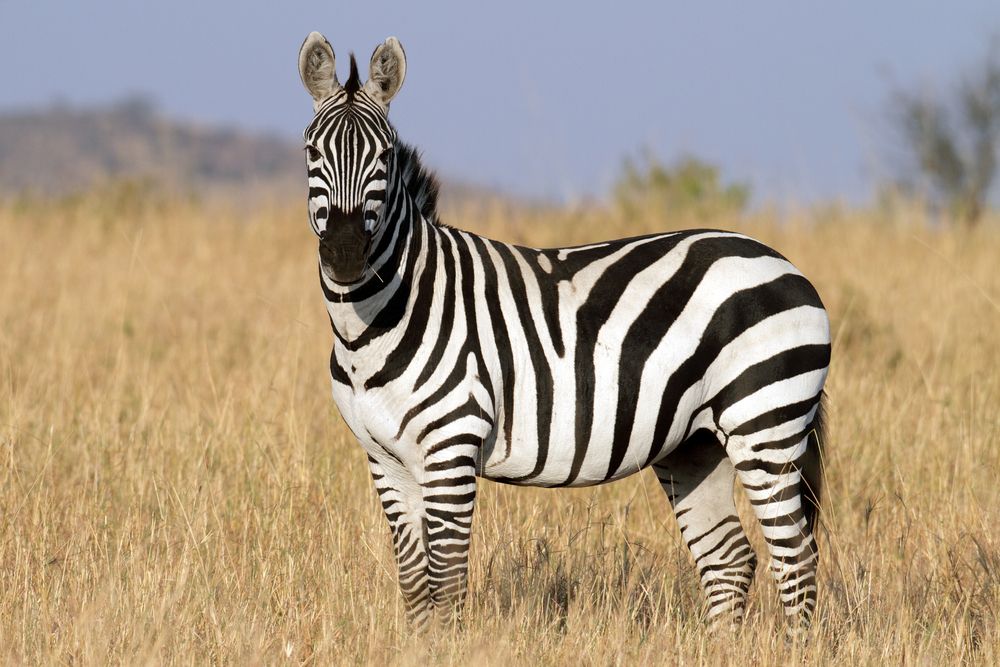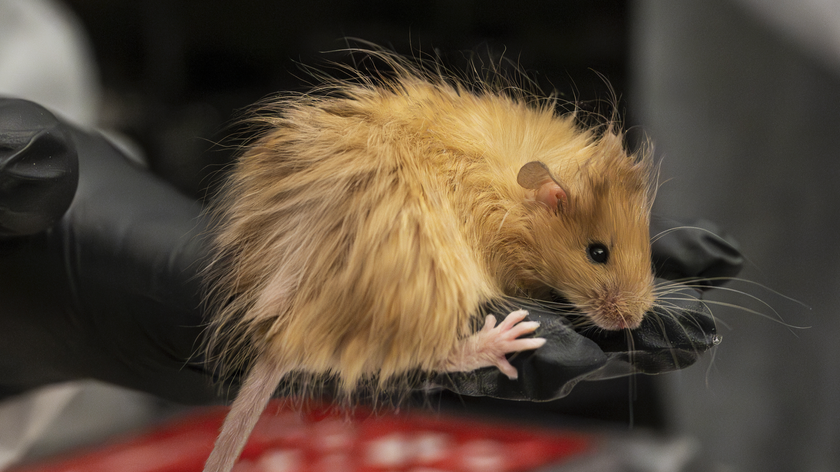Zebra Facts
These black and white equids live in East and southern Africa.

Zebras are single-hoofed animals that are native to Africa. Zebras are very closely related to horses and donkeys; in fact, they are in the same genus, Equus. The most prominent feature of zebras is the bold patterns on their coats.
Zebras have white stripes next to black or brown stripes, with the stripes ending at their bellies and the inner side of the legs, which are white, according to the San Diego Zoo. However, zebras have black skin under their coats.
Each species of zebra has a different general pattern of stripes. The Grevy's zebra has very thin stripes. The mountain zebra has vertical stripes on its neck and torso, but horizontal stripes on its haunches. Some subspecies of plains zebras have brownish "shadow" stripes between the black stripes, according to the San Diego Zoo.
Zebras' stripes may make them appear unattractive to smaller predators, such as bloodsucking horseflies, which can spread disease, according to a 2020 study published in the journal Proceedings of the Royal Society B. In addition, the stripes may work as a natural sunscreen.
Each zebra's stripes are unique. Just as no two human fingerprints are alike, no two zebras have the same stripe pattern.
Size
The largest zebra is the Grevy's zebra, according to the San Diego Zoo. It weighs 770 to 990 pounds (350 to 450 kilograms) and is around 5 feet (1.5 meters) tall from shoulder to hoof. Their thick bodies make them look like mules with stripes.
Mountain zebras are from 3.8 to 4.9 feet (116 to 150 cm) tall at the shoulder and weigh 529 to 820 pounds (240 to 372 kg), according to the University of Michigan Museum of Zoology.
Plains zebras are 3.6 to 4.8 feet (1.1 to 1.5 m) at the shoulder and weigh up to 770 pounds (350 kg), according to the African Wildlife Foundation.
Habitat
Though they all live in Africa, each species of zebra has its own home area. Plains zebras live in the treeless grasslands and woodlands of eastern and southern Africa. The Grevy's zebra lives in the arid grasslands of Ethiopia and northern Kenya. The mountain zebra is found in South Africa, Namibia and Angola.
Behavior
Plains zebras and mountain zebras live in family groups led by a stallion, with several mares and offspring. Family groups (known as harems) sometimes get together to form loosely associated herds, according to the San Diego Zoo. However, Grevy's zebras don't have herds. Instead, stallions establish territories and mares cross into them to breed and give birth. Once the foals are old enough to travel, they and their mothers move on.
Zebras have several ways they communicate with one another, including the facial expressions of wide-open eyes and bared teeth. They also bark, bray, snort or huff to get their point across. Even the position of their ears can signal their feelings, according to the San Diego Zoo. For example, ears flattened back means trouble. Another habit of zebras is mutual grooming, which they do to strengthen their bonds with each other.
Known predators of zebras include lions, leopards, cheetahs and hyenas. When danger approaches, the stallion will alert the others with a high-pitched snort, according to the University of Michigan. He will stand his ground while the rest of the family runs away in zigzag fashion. If he must fight, he will lower his head with neck outstretched and teeth bared, prepared to bite. However, running away is the usual tactic, sometimes accompanied by a defensive kick. The kick can be powerful, though, and can cause serious injury to a predator.
Diet
Zebras eat mostly grass and will travel up to 1,800 miles (2,900 kilometers) in search of food, according to the African Wildlife Foundation. Some zebras also eat leaves and twigs.
Offspring
Female zebras carry their young for a gestation period of 12 to 14 months. Baby zebras are called foals. When they are born, foals weigh around 55 to 88 pounds (25 to 40 kg), according to the San Diego Zoo. Soon after birth, foals are able to stand up and walk. The young zebra gets its nutrition from its mother's milk and will continue to nurse throughout its first year. Zebras become fully mature at 3 to 6 years old and will have a lifespan of around 25 years.
Classification/taxonomy
Some experts say that there are three species of zebras — Grevy's zebra, plains zebra and mountain zebra — and that Hartmann's zebra is a subspecies of mountain zebra. Other experts say Hartmann's zebra is a separate species.
For example, the International Union for Conservation of Nature (IUCN) says genetic analysis does not support the hypothesis that Hartmann's zebra is a separate species. The Integrated Taxonomic Information System (ITIS), a service of the U.S. Fish & Wildlife Service, on the other hand, lists four species.
Likewise, the IUCN says a 2008 study of 17 plains zebra populations that represented five of the six subspecies found very little differentiation among them and concludes that the subspecies splits may be arbitrary. ITIS, however, lists six subspecies of plains zebra.
The taxonomy of zebras, according to ITIS, is:
- Kingdom: Animalia
- Subkingdom: Bilateria
- Infrakingdom: Deuterostomia
- Phylum: Chordata
- Subphylum: Vertebrata
- Infraphylum: Gnathostomata
- Superclass: Tetrapoda
- Class: Mammalia
- Subclass: Theria
- Infraclass: Eutheria
- Order: Perissodactyla
- Family: Equidae
- Genus: Equus
- Species:
- Equus grevyi (Grevy's zebra)
- Equus hartmannae (Hartmann's zebra, Hartmann's mountain zebra)
- Equus zebra (Cape mountain zebra, Mountain zebra)
- Equus quagga (Plains zebra)
Subspecies of plains zebra:
- Equus quagga boehmi (Grant's zebra)
- Equus quagga borensis (Half-maned zebra)
- Equus quagga burchellii (Zululand zebra, Damara zebra, Burchell's zebra, Bontequagga)
- Equus quagga chapmani (Chapman's zebra)
- Equus quagga crawshayi (Crawshay's zebra)
- Equus quagga quagga (Quagga; extinct)
Conservation status
Each species of zebra has its own conservation status. According to the IUCN's Red List of Threatened Species, the plains zebra is not endangered, while the mountain zebra is considered vulnerable and the Grevy's zebra is endangered. The Red List also lists Hartmann's zebra (as a subspecies of mountain zebra) as vulnerable.
The mountain zebra is considered vulnerable because its population is low and susceptible to decreasing. According to the IUCN, the mountain zebra has a population of only around 9,000 adults.
Though the population of the Grevy's zebra is stable, it is considered endangered because its numbers are so small. The Grevy's zebra has a population of just 1,966 to 2,447, according to IUCN.
The quagga, considered since 1984 to be a subspecies of plains zebra based on genetic evidence, has been extinct since the 19th century, when the last one died at the Amsterdam Zoo in 1883.
Additional resources
Sign up for the Live Science daily newsletter now
Get the world’s most fascinating discoveries delivered straight to your inbox.













